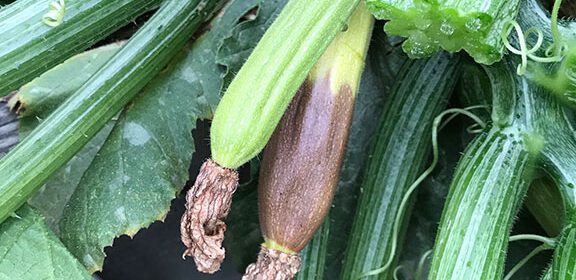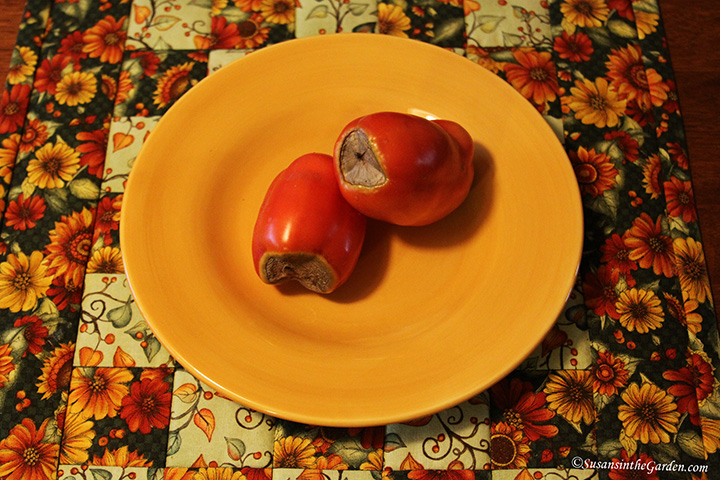Aug. 8 Column: Blossom End Rot

Blossom end rot. Those three words strike terror (or at least, disgust) into the hearts of vegetable gardeners everywhere! I felt it was high time I devoted a column to this topic. Why? There is so much misinformation and confusion about what blossom end rot is. What’s more, many folks don’t understand what causes it and how to prevent it. You can read my column in today’s edition of The Spokesman-Review: Blossom-end rot common problem in tomatoes, peppers and squash. (or you can read it underneath the video below)
For my column, I did a LOT of research on blossom end rot. I only consulted research-based institutions (i.e., from educational and Extension sources). As both a Master Gardener and writer, I feel it’s so important to focus on reliable information. I want to be able to provide you with information you can trust.
And guess what? Blossom end rot is also the topic for this week’s video! I know some folks don’t use social media. But they might YouTube videos, so I’m trying to cover all the bases here. It is my hope that you will find all of the information very useful. A little knowledge goes a long way to understanding a problem and preventing it from occurring. You’ll find my video below my garden column.
Column:
There you are, enjoying a lovely stroll through your vegetable garden. Then something out of the ordinary catches your eye. You head over to the tomato plants that you’ve been anxiously waiting to harvest from. You’re greeted with an ugly brown, sunken spot at the bottom of several tomatoes.
That is blossom-end rot. It’s not caused by a disease or an insect but it sure is discouraging. Blossom-end rot is actually a nutritional disorder. It occurs during a plant’s development and it most commonly affects the first fruits it produces.
Unfortunately, this disorder isn’t limited to tomatoes. It also can occur in eggplants, peppers, watermelons, pumpkins, zucchinis and other types of squash.
Here’s what you need to know:
The main cause of blossom-end rot is a lack of calcium within the developing fruits. It can happen if there isn’t much calcium in the soil but that’s very unusual. Instead, the problem occurs because the plant’s roots aren’t able to transport calcium from the soil to the fruit.
Drought conditions and infrequent watering are the two most common reasons for this. Calcium only moves from consistently-watered soil to the roots and then up into the plants. Damaged plant roots also contribute to blossom-end rot. That’s because they aren’t able to move calcium to the areas that need it the most.
When fruiting plants are given a lot of nitrogen fertilizer, calcium moves to the resulting leafy green growth. This is at the expense of the developing fruits. Those fruits require a constant supply of calcium in order to develop normally.
Seedlings transplanted into the garden when the soil was still cold are more susceptible to developing blossom-end rot. The ideal soil temperature for planting tomatoes is between 65 and 70 degrees Fahrenheit. This applies to other warm-season crops, too.
With this year’s drought conditions and excessively high temperatures will likely cause more blossom-end rot than usual. These challenges have been beyond our control. But here are some suggestions for preventing blossom-end rot in future growing seasons:
How to prevent blossom-end rot
- Water your plants consistently. Tomato plants require about an inch of water per week.
- Mulch around your plants to help the soil retain moisture. Ideal materials include shredded leaves, weed-free straw or grass clippings from a lawn that hasn’t been treated with herbicides.
- Avoid over-fertilizing plants with high-nitrogen fertilizers. How do you know if that’s what you’re using? The first number on the package will be the highest. I know we’re all anxious for those first ripe tomatoes of the season, but hurrying the process along will increase the occurrence of blossom-end rot.
- Don’t cultivate around your plants’ root systems because this will damage them and impact their ability to transport calcium up into the plant.
- Remove affected fruits from the plants but rest assured that blossom-end rot doesn’t spread from fruit to fruit. The good news is that later-developing fruits usually aren’t impacted by it.
- Adding calcium to the soil is unlikely to eliminate the problem because that’s rarely what caused it in the first place. However, if you have problems with blossom-end rot every year, a soil test is in order to evaluate the calcium levels.
- Foliar applications of calcium won’t prevent or resolve the problem because calcium can’t move from the leaves to the fruits.

